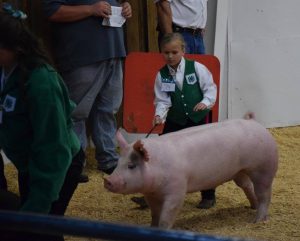
Animals are an important component of Florida’s agriculture industry and fairs and shows across the state. Livestock shows and exhibition allow youth the opportunity to showcase their animals and educate the general public about food and fiber animal production.
The commingling of animals of different species, breeds, and ages, from multiple premises and herd management backgrounds creates an environment for potential exposure and spread of animal diseases. The stresses of travel, close confinement, and a changing environment, may compromise an animal’s resistance to disease. People, exhibitors and general fairgoers, can also contribute to potential disease spread. For these reasons, responsible animal owners need to implement certain practices before, during, and after the fair to protect their animals.
Implement the following Biosecurity practices to help protect your animals at the fair and at home on the farm. It important to remember that the following are suggested practices that reduce the potential for disease outbreaks and not all of these practices are necessarily practical to every producer.
Before and During the Fair
- Monitor visitors to your animals and farm especially if they have traveled outside the country within the past week.
- Make sure all veterinary health inspections and certificates of veterinary inspection are current for all the animals you will take to the fair.
- Recommend separate barns for separate species.
Follow the fair vaccination guidelines and give recommended vaccinations at least 10 days before the event. - Disinfect all equipment, such as buckets, shovels, wheelbarrows, manure baskets, lead ropes, blankets, snares, clippers, scissors, brushes, show box, before entering the fairgrounds.
Don’t share equipment with other exhibitors unless it has been cleaned and disinfected before and after use. - Avoid entering the pens/stalls and coming in contact with animals from other farms. Contact the fair veterinarian or exhibition manager when animals are in need of attention. If you must contact animals from different premises, properly wash your hands and thoroughly clean and disinfect your boots and clothing before returning to your animals.
- As much as possible, minimize feed and water changes from home to fair.
- Keep unused equipment and feed bagged or covered to reduce the risk of contamination.
- Vehicles and trailers used to transport animals to and from the fair should be well cleaned and disinfected, inside and out, between uses.
- Do not mix species in the same trailer (especially sheep/goats with cattle). Avoid commercial haulers with multiple animals from multiple farms.
- Clean and disinfect all items at the end of the fair before taking them home.
- Properly dispose of unused bedding, hay, and feed after the fair. Do not bring it home.
- Minimize stress by keeping animals cool, well bedded and comfortable.
- Carefully consider whether exhibition animals should return home after the fair, and what risk that presents to other animals at home. If an animal becomes ill at the exhibit, consult a veterinarian and isolate the animal.
After the Fair
- The safest way to transport your animals is in your own vehicle. Do not haul animals from other farms.
- Keep fair animals isolated from other animals and pets for at least 30 days.
- Check these isolated animals every day for any signs of illness.
- Care for isolated animals separately, then shower, change your clothes, and clean and disinfect your boots before going to other areas of the farm.
- The person caring for animals at the fair should not perform animal‐related chores at home. If the same person must do both, chores at home should be done first. Do not wear the same clothes, hats, and shoes to care for the animals at home and the fair animals. Garments should be cleaned and disinfected between each trip to the fairgrounds and barn/pasture. (It’s also a good idea to shower between trips.)
- Contact a veterinarian as soon as you see any unusual symptoms in any animal.
 0
0
